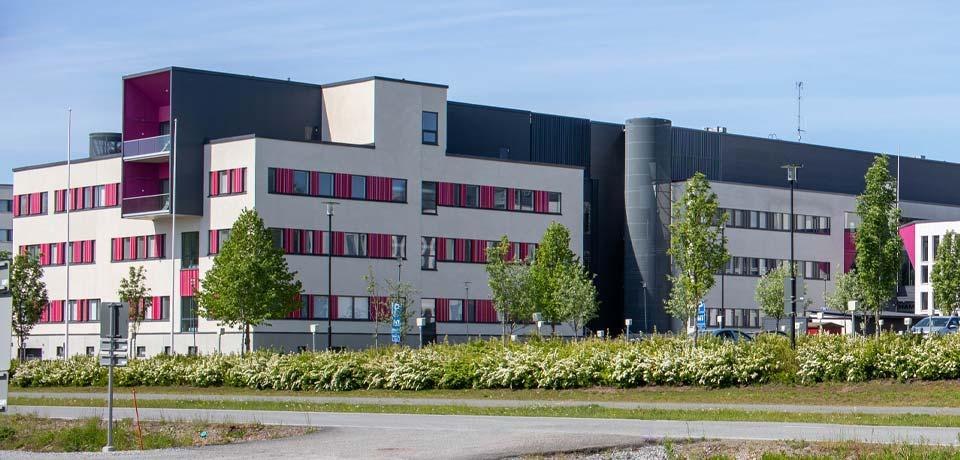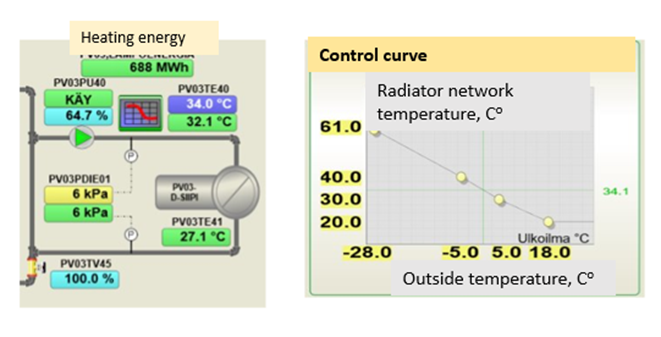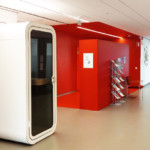
Wangkang Jin, Atte Partanen, Roman Tsypin & Jukka Pulkkinen
Increasing energy efficiency has become an important part of the sustainable development of buildings. Our research addresses the question of finding ways to improve the energy efficiency of the heating, ventilation, and air condition (HVAC) systems of public school buildings by fine-tuning and verifying the energy-saving potential in practice. Our study focuses on Häme University of Applied Sciences’s (HAMK) S building at the Hämeenlinna University Centre where practical tests were implemented in the heating season 2021–22. Our saving potential prediction was done by using an artificial neural network (ANN) model to predict energy consumption. Our one assumption is that HVAC systems are tuned based on previous experience and building-specific detail information is not taken into account. Our results show a 3–7% saving potential with the indoor air temperature staying at accepted levels at the same time indicating that there is potential for energy savings in public school buildings.
Introduction
Increasing energy efficiency plays an important role in the sustainable development of buildings. Sustainable development is not only limited to finding ecologically appropriate sources of energy, but also to exploring possibilities in the reduction of energy consumption. Tackling the latter question is particularly important because saving energy is the best way to reduce CO2 footprint. Our research addresses the question of finding ways to predict energy savings by fine-tuning HVAC control systems.
The Finnish Construction Industries states that 25% of energy consumption and up to 30% of greenhouse gas emissions in Finland originate from buildings (Rakennusteollisuus RT ry, 2020). Due to the important role of buildings, building owners need to implement proactive actions to meet the very challenging target which is to make a 55% reduction in the energy consumption of buildings compared to the levels of 2005 (Ministry of the Environment, 2020).
The heating, ventilation, and cooling system (HVAC) is the main system in the building which determines how energy is actually used to ensure sufficient indoor air quality parameters like temperature, CO2 and humidity (Mathews et al., 2001; Lo & Novoselac, 2010; Idahosa & Akotev, 2021). Generally, the HVAC controls several temperature systems in a building like the radiators, the ventilation, the floor, and the domestic water temperature. Our study aims to analyze the possibility of saving energy by fine-tuning the control of the radiator network temperature. The purpose of the radiator network temperature is to ensure enough heating capacity for the radiators to have the indoor temperature at an acceptable level. Therefore, it is very understandable that the radiator network temperature depends on the outside temperature—the colder the outside temperature, the warmer the radiator network temperature. The typical correlation between the outside temperature and the radiator network temperature is presented on the right side of Figure 1. We can see the setpoint for the radiator network temperature PV03TE40 and it is 34oC corresponding about -5oC outside temperature.

Our study aims to find the answer to the following research questions:
“What is the impact on energy consumption and on indoor air temperature when the radiator network temperature is reduced?”
Our study was done at the HAMK’s S building at Hämeenlinna University Centre.
One motivation for our study is the Energy Performance of Buildings Directive (EPBD) and the Energy Efficiency Directive of the European Union which promote increasing the intelligence of buildings because this can have amajor impact on improving their energy efficiency (Ożadowicz, 2022). In addition to this, there are several studies done in the literature that demonstrate the energy saving potential of adjusting the HVAC system (Mathews et al., 2001; Rocha et al., 2015; Petri et al., 2017; Avila et al., 2021).
Methodology
The Building Automation System (BAS) allows us to set the desired temperatures of a particular network. Therefore, by manually changing the target temperature of the radiator network, we can see its impact on the final energy consumption and the indoor temperature, provided we keep other controls as they were. In our study, the target temperature for the radiator network was reduced by -3oC, -4oC, -5oC, and -6oC from the original target value.
In order to effectively draw conclusions, we should compare the energy consumption between two scenarios: 1. the original target value for the radiator network, and 2. the reduced target values. To make this comparison, we used an artificial neural network model which was developed by (Metsä-Eerola, 2021) to predict energy consumption. The features and dependent variables of the model are listed in Table 1.
| Feature | Use | Source | Unit |
| District heating energy consumption | Target | Monitoring tool | kWh |
| The valve of domestic hot water network 1 | Input | BAS | % |
| The valve of domestic hot water network 2 | Input | BAS | % |
| Water temperature of incoming district heat | Input | BAS | oC |
| 24-hour rolling average of outside temperature | Input | BAS | oC |
| Water temperature of ventilation network 1 | Input | BAS | oC |
| Water temperature of ventilation network 2 | Input | BAS | oC |
| Water temperature of radiator network 1 | Input | BAS | oC |
| Water temperature of radiator network 2 | Input | BAS | oC |
| Average facility CO2 concentration | Input | BAS | ppm |
| Outside air relative humidity | Input | FMI | % |
| Solar irradiance | Input | CAMS | w/m2 |
| Hour of the day | Input | Timestamp | h |
| Day of the week | Input | Timestamp | d |
The features (Input) are gathered from the BAS, IoT sensors, the Finnish Meteorological Institute, and CAMS. In addition to this, artificial input features were created to describe seasonal behavior by calculating the seasonal signals for the hour of the day and for the day of the week. The dependent feature (Target) is district heating energy consumption, and it is collected from the Energy Management system.
Results
The ANN model was created using data collected between 29.11.2021 and 14.2.2021. The first 80%, which is from 29.11.2021 to 24.01.2022, is used for training while the last part is for testing. The simulated and measured district heating consumption is presented in Figure 2.

The model’s results to the key performance indicators are listed in Table 2. The mean absolute percentage error (MAPE) was 3.693% for the training and 3.673% for the testing dataset. Modelling results are presented in Figure 2. We can see that the measured temperature is very close to the simulations. This means that we can predict the district heating consumption accurately by using the features defined above.
| Algorithm | Dataset | MSE ((C)²) | RMSE (C) | MAE (C) | MAPE |
| GRU model | Training Testing | 21.936 15.468 | 4.684 3.933 | 3.572 2.743 | 3.693% 3.673% |
The simulation results for the different radiator network temperatures are presented in Figure 3. The standard scenario corresponds to the simulation where the normal radiator network temperature is used, and the modified scenario corresponds to the simulation where offset reduction was added to the normal radiator network temperature. From the period when we have the temperature offsets, we can clearly see that reducing the target temperature of the radiator network allows us to save energy, and the higher offset we have, the higher saving we gain. In Figure 4, we can see the summary of the energy saving potential by different offsets based on our simulation and the savings vary between 3.2% and 6.7% depending on offsets. Naturally, each room has its own thermostat to keep the inside temperature stable and they were not analyzed individually in more detail in our study due to a lack of data from thermostats. Nevertheless, these thermostats are part of the modelled system and therefore they are taken into account in the energy saving calculations. Another important aspect is the outside air heating in the HVAC which can try to compensate for the reduced radiator network temperature. This was analyzed after tests, and this compensation did not occur in our tests.
At the same time, although we reduced the radiator network temperature, which is one of the key components of the temperature control in the building rooms, we were still able to stay within the acceptable temperature conditions for students. This is very clearly presented in Figure 5 where we can see the measured inside temperature of the building during our test. This temperature is the sum of all rooms’ temperatures, and we can state that all individual rooms are also within tolerances.



Conclusion
In our study, we have analyzed the potential energy savings when reducing the radiator network temperature in HAMK’s S building. The results indicate about 3–7% savings when reducing the radiator network temperature starting from 3oC and ending to 6oC. We have also compared our predicted savings to the generally used method in the field which is based on energy comparison where the degree day calculation is taken into account. This method ended with about -11% savings during February 2022 compared to February 2021 which is slightly higher than our estimation. Nevertheless, we strongly believe that our model is more accurate than the generally used method which is based on general average assumptions.
Our research results can be developed further by calculating the confidential intervals (95%) to get scientifically significant results for the energy savings. On the other hand, the first results are in any case promising and are encouraging us to continue this development further. One of our assumptions was that the current control of the HVAC is done on a very general level and not optimized for specific buildings, which means that there would be potential for energy savings from considering the unique behavior of specific buildings in more detail. In practice, a data-driven approach would make this possible and this would also open a path to scale up the personalization of a larger number of buildings, which would have a more significant impact on energy savings and CO2 footprint reductions.
Wangkang Jin is studying currently autonomous systems in KTH Royal Institute of Technology, Sweden and before starting in KTH he completed several machine learning related courses in Aalto university. Now he is working in HAMK Smart research unit as project engineer in ÄlyKaupunki project.
Atte Partanen holds a Bachelor of Business Administration, Automation Engineering from Häme University of Applied Sciences. Now he is working in HAMK Smart research unit as solution specialist in ÄlyKaupunki project and his research interest is IoT technology.
Roman Tsypin holds a Master’s Degree, Economics and Business administration from Hanken School of Economics and Bachelor of Business Administration, Computer Application from Häme University of Applied Sciences. He has been working in the HAMK Smart research unit as project engineer in ÄlyKaupunki project.
Jukka Pulkkinen holds a Ph.D. in Automation and System Technology from the Helsinki University of Technology. Currently, he is the director of HAMK Smart research unit at Häme University of Applied Sciences. From 2003 to 2017, he held several management positions in Valmet. He has also held a few research positions at the Tampere University of Technology in the 1990s.
References
Avila, M., Méndez, J. I., Ponce, P., Peffer, T., Meier, A., & Molina, A. (2021). Energy management system based on a gamified application for households. Energies, 14(12), 1–27. https://doi.org/10.3390/en14123445
Idahosa, L. O., & Akotey, J. O. (2021). A social constructionist approach to managing HVAC energy consumption using social norms – A randomised field experiment. Energy Policy, 154(June 2020), 112293. https://doi.org/10.1016/j.enpol.2021.112293
Lo, L. J., & Novoselac, A. (2010). Localized air-conditioning with occupancy control in an open office. Energy and Buildings, 42(7), 1120–1128. https://doi.org/10.1016/j.enbuild.2010.02.003
Mathews, E. H., Botha, C. P., Arndt, D. C., & Malan, A. (2001). HVAC control strategies to enhance comfort and minimise energy usage. Energy and Buildings, 33(8), 853–863. https://doi.org/10.1016/S0378-7788(01)00075-5
Metsä-Eerola, I. (2021). On Forecasting Heating Energy Consumption of HVAC Systems with Recurrent Neural Networks.
Ministry of the Environment. (2020). Pitkän aikavälin korjausrakentamisen strategia 2020-2050. https://ym.fi/documents/1410903/38439968/Suomen-EPBD-2a-ilmoitus_final_10-03-2020-242AE19E_F497_4A38_8DF2_95556530BA53-156573.pdf/37a549e9-b330-5f8c-d863-2e51f2e8239a/Suomen-EPBD-2a-ilmoitus_final_10-03-2020-242AE19E_F497_4A38_8DF2_95556530BA53-156573.pdf
Ożadowicz, A. (2022). A Hybrid Approach in Design of Building Energy Management System with Smart Readiness Indicator and Building as a Service Concept. Energies, 15(4). https://doi.org/10.3390/en15041432
Petri, I., Kubicki, S., Rezgui, Y., Guerriero, A., & Li, H. (2017). Optimizing energy efficiency in operating built environment assets through building information modeling: A case study. Energies, 10(8), 1–17. https://doi.org/10.3390/en10081167
Rakennusteollisuus RT ry. (2020). Leijonanosa rakennetun ympäristön päästöistä aiheutuu kiinteistöjen lämmityksestä. https://www.rakennusteollisuus.fi/Ajankohtaista/Tiedotteet1/2020/leijonanosa-rakennetun-ympariston-paastoista-aiheutuu-kiinteistojen-lammityksesta/
Rocha, P., Siddiqui, A., & Stadler, M. (2015). Improving energy efficiency via smart building energy management systems: A comparison with policy measures. Energy and Buildings, 88, 203–213. https://doi.org/10.1016/j.enbuild.2014.11.077





